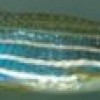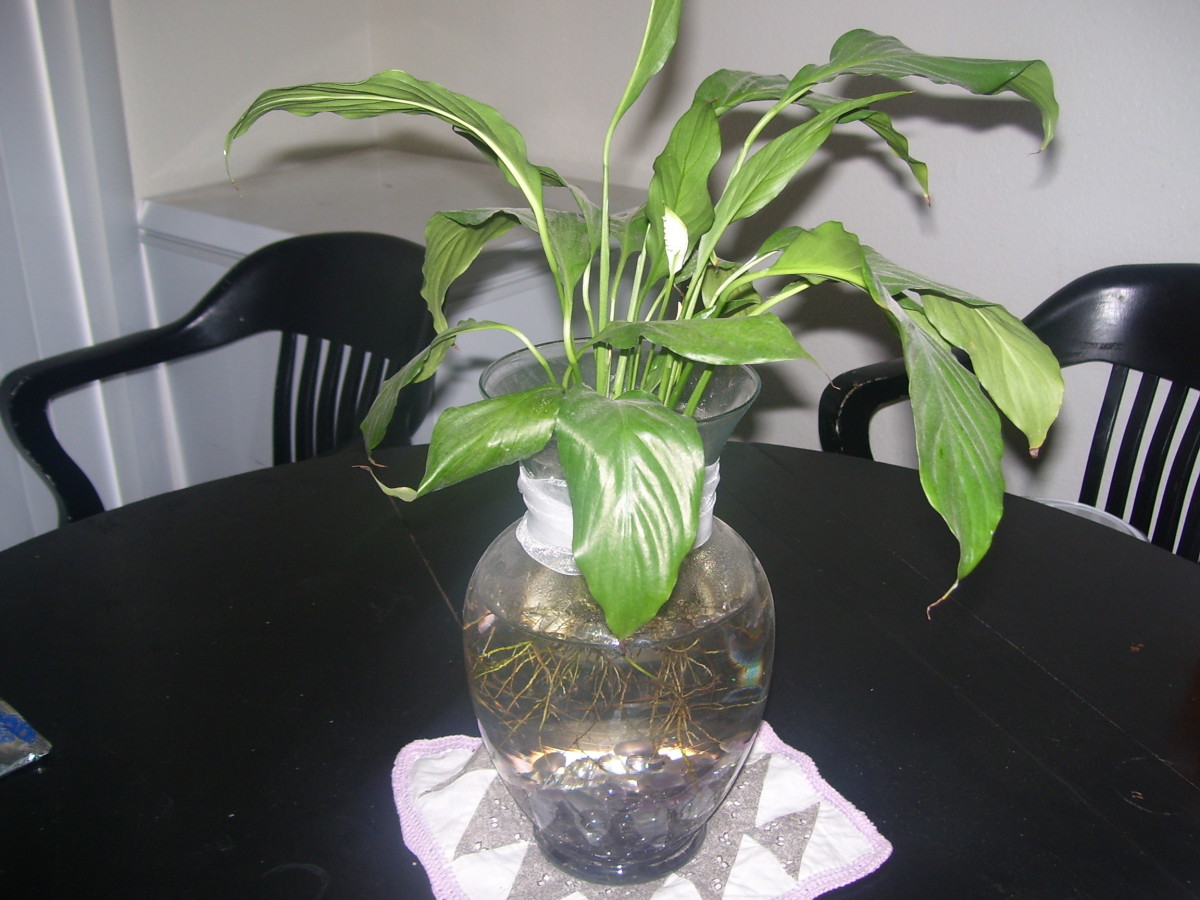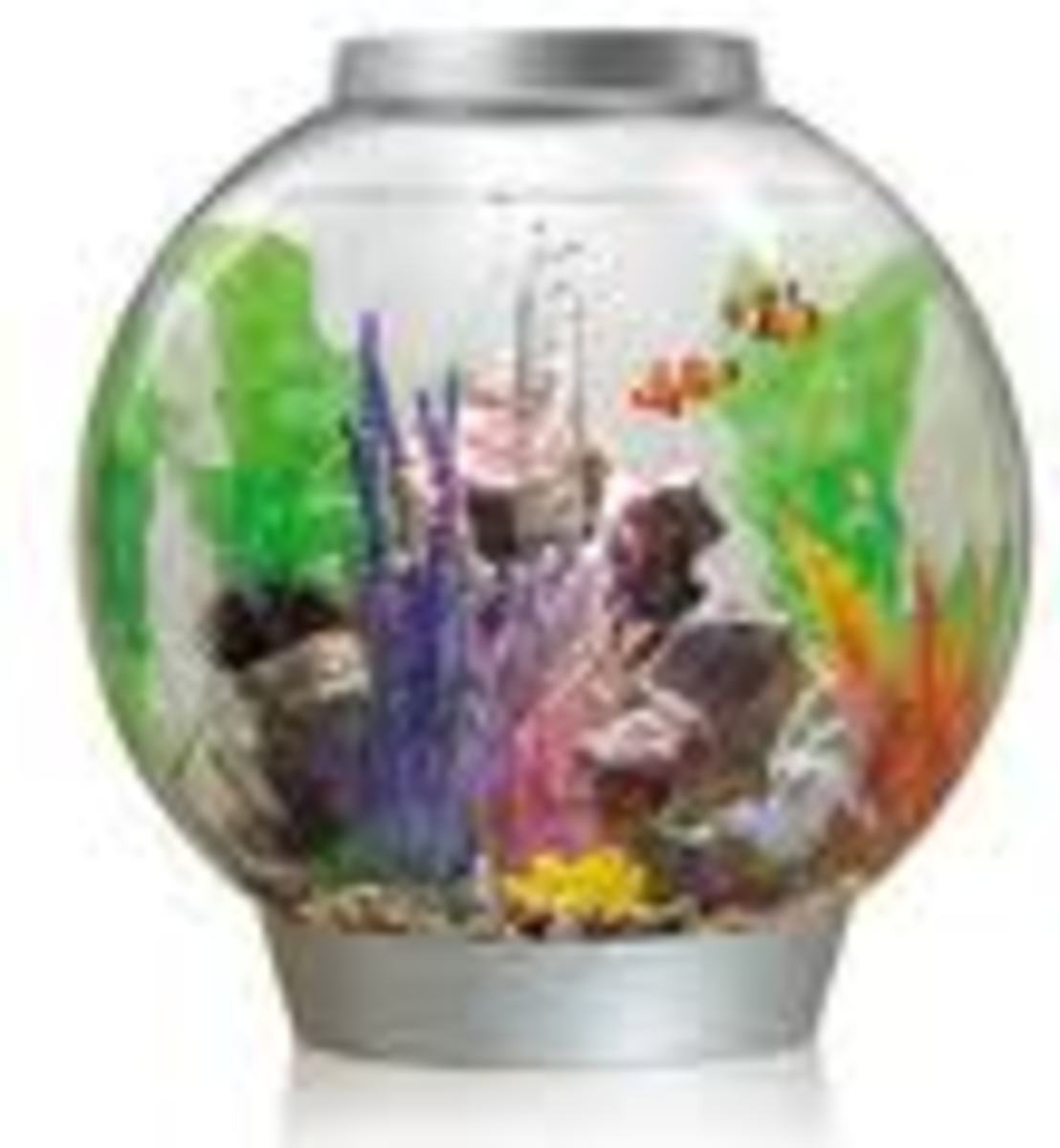- HubPages»
- Pets and Animals»
- Tropical Fish & Aquariums»
- Aquariums & Fishbowls
Everything to Know About Starting A Tropical Fish Tank Aquarium
Determine What You Want Out of a Fish Tank
The first step to setting up a successful tropical or freshwater fish tank that suits your needs is determining what exactly it is you wish to gain from it. A freshwater fish tank can be anything from a simple home for a single fish that requires little maintenance to a large tank that houses a variety of tropical warm-water fish as well as an array of live plants, snails, dwarf frogs, crabs or shrimp.
While both can be wonderfully gratifying projects, the latter can be a very fulfilling lifetime hobby, which will require much more in the way of regular maintenance as well as some ongoing investment of funds. Don't let that put you off though, if you have an hour or two of spare time every week, and are able to put a few dollars into it -mostly upfront- then this can be a fun and rewarding past-time that fish-keepers everywhere will tell you is very addictive and satisfying.
If you've always wanted a fish tank, or have just lately been intrigued by seeing one somewhere, than the more in-depth approach may be for you. If you're just looking for a simple tank to house a quiet pet or add a touch of water and life to your decor, something simpler will be in order. There are, of course, many options in between the two to choose from as well.
Fish keeping on a larger scale can be difficult to master at first, so even if you're looking to replicate the 120 gallon discus tank you saw at a friend's house, it will probably be better to start with something smaller and simpler at first. That said, once you start, people often find that fish keeping is a lot like Pokemon card collecting, and you've just 'got to catch them all!' If you think you may be susceptible to that, it's probably going to be better for you to go ahead and start out big. No sense starting with a 20 gallon if you're pretty sure you're going to want to replace it with a 75 gallon before long. Additionally, larger sized aquariums are in fact easier to maintain with balanced water, as smaller sized tanks are more inclined to suffer wide changes in conditions. A larger tank is more forgiving, which gives you the perfect excuse to splurge.
This Hub Includes Info. About
- Determining What You Want From an Aquarium
- About Goldfish
- Live Plants vs. Synthetic Plants
- Complete List of Start-up Materials
- Choosing a Fish Tank
- Choosing a Filtration System
- Choosing Substrate
- Choosing Lighting and Hood
- Other Necessary Start-Up Supplies
- Setting It All Up
- Add Fish and Enjoy!
Of course, if you have the room, the time, and the money, you can always have multiple tanks, one in every room perhaps, or even a dedicated fish room as many fish-keepers do. Practically speaking, however, one tank fits better into most of our busy lifestyles, so go ahead and plan for the biggest one you want that fits your home and suits your needs and fish keeping desires.
Know ahead of time where you’re going to place the tank. It will require a sturdy, stable base, and depending on the size of the tank, you may want to take into consideration the strength of the floor as well. For a larger, heavier tank, try to make sure the base it sits on is resting across floor joists, and not in between them where an older floor may be weak.
Position your fish tank out of direct sunlight. The more sunlight your aquarium receives the harder it is to control the water temperature. Increased sunlight also leads to more algae growth, which can be very difficult to eradicate. Once your fish tank is filled with water, or even partially filled with water, it will be very difficult to move, so choose the perfect spot for it before you get started.
Other things to take into consideration when planning what kind of tank you want is what kind of fish you want and what kind of water supply you have on hand. While some fish prefer softer water on the acidic side, others prefer harder, less acidic water. Many fish will fit into a wider range, but if you're heart is set on angelfish -which require soft water to thrive- you're going to have a hard time meeting the fish's needs if your tap water is hard.
There are ways around this, such as always purchasing distilled water, but that can be impractical, and is something you have to determine whether or not it will be feasible for you. Fish stores often sell products to adjust your water parameters, but to alter the parameters of your natural water supply is an ongoing struggle that you will generally lose, unless you have the time, funds and experience to devote to the endeavor.
A good way to go is to test your home tap water to see whether it is hard or soft and acidic or more alkaline, and choose your fish accordingly based on that. There is plenty to choose from no matter what your natural tap water parameters may be.
Another important decision you will have to make prior to setting up your new tank is what method of cycling you're going to use. Cycling a new fish tank is basically a matter of getting your water well balanced. Fish wastes will release ammonia into the water, which is very unhealthy and in fact deadly to the fish. So your water must be 'cycled' prior to the addition of fish in order to achieve a natural system of water purification. There are a few different methods of cycling a tank. I prefer a simple method of fishless cycling which uses bottled ammonia to jump-start the process. You can read more about that method here.
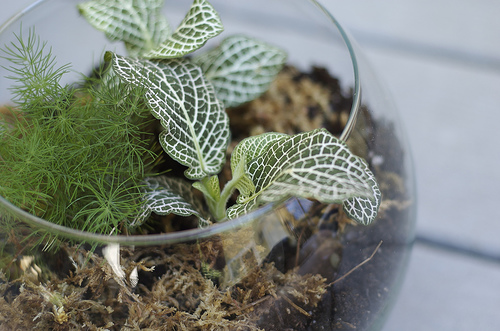
About Goldfish and Fish Bowls
Goldfish can not be maintained in a bowl and stay in good health. No fish can be maintained in a bowl and stay in good health. Bettas, or Siemese Fighting Fish, are another type of fish commonly touted to unwary buyers as perfect for the fish bowl. It simply isn't true. Outside of being cruel and stressful for the fish, many more diseases are likely to flourish in fish bowl conditions, no matter how often you change the water. Bettas shouldn't be kept in anything smaller than a 5 gallon tank -or filtered fish bowl. Goldfish require at maturity at least twenty gallons.
Most fish keepers will tell you that goldfish should not be housed with any other fish, due to the fact that goldfish are truthfully heavy ammonia producers, which can be harmful to other fish. Further, fancy goldfish should not be kept with common or comet goldfish or shubunkin goldfish, as the fancier goldfish are slower and will not be able to compete for food. The other thing to know in advance regarding keeping goldfish in an aquarium is that they require much more space than other freshwater fish. This added space requirement has to do with their high oxygen needs and potential mature sizes as well as for needing the extra water to dilute their particular dirtiness.
I would say, as would some others, that it is okay to keep certain other fish with goldfish, as long as they are otherwise compatible, with similar needs, the space is there and regular maintenance is religiously performed. But as goldfish grow larger, and more likely to eat fish smaller than them, the list of fish they can live with shrinks. Click here to read my hub regarding good tankmates for goldfish.
Live Plants vs. Synthetic
It is best to consider whether or not you will want live plants or synthetic ones prior to setting up your tank. Particularly in a larger sized tank, you will not want to purchase several synthetic plants only to be replacing them later with live plants. This will end up costing you twice as much in the long run, and will just save you time and hassle as well. Additionally, if installing live plants, you may want to use a different type of substrate, and depending on your plant choices, you may even require a better lighting system, so it only makes sense to make this decision in advance.
Live plants in your fish tank can offer a whole new dimension to the pleasures you receive from your tank, as well as a different dynamic to your tank needs and some natural benefits as well. Tanks planted with live plants are much less likely to experience ugly algae blooms, and offer increased oxygen content too. While many live plants for your tank will require special lighting and CO2 injectors, there remains a great deal of water plants for your tank that do not require these higher tech conditions to thrive. Either way, live plants can add extra beauty and interest to your tank, and though synthetics are a fine option, personally I have to recommend live plants whenever possible. The benefits your tank will gain from them and the ease of care which many live plants offer make it really the best choice with no reason to choose otherwise.
Comparatively priced to synthetic plants, live plants such as Java Ferns, Anubias and Cryptos are good beginner choices. An easy option is the inexpensive Aponogetons and Lilies sold everywhere. Aponogetons grow from a rhizome into tall grass-like leaves with ruffled sides, and do wonderfully along the back of your tank. Lilies grow from bulbs, and are better placed in the middle area of the tank. Although Lilies will grow tall, in the tank they are better to keep medium sized. Using Java Ferns and Anubias Nana plants in the front section of your tank will give you plenty of growth and variety to start with, and no fuss involved.
Purchase Initial Supplies
Once you've decided what you want, and figured out how you’re going to achieve that, it's time to go shopping and purchase your initial start up supplies. While much of your tank décor and synthetic plants can wait till later, to begin the setup of your tank, you will need the following items:
- Tank
- Filtration System
- Substrate
- Lighting (must have in place for live plants)
- Heater (optional)
- Ammonia (pure)
- Water Testing Supplies for Ammonia and Nitrite Levels
- Water Dechlorinator
- Water Siphon/Gravel Vacuum
- Five Gallon Buckets
- Live Plants and/or Bulbs (if you wish to get them started growing early)
- Aquarium Plant Fertilizer (optional)
- BioSpira or Filter Medium from Established Fish Tank (optional)
These items will get your tank set up and through the cycling process.
Choosing a Fish Tank
The most obvious of your initial needs is going to be the tank itself. Assuming you have determined how big you want it, and where you're going to put it, there are only a couple further considerations. First, longer and/or wider is usually better than taller and skinnier. It allows more elbow room for your fish and a greater amount of surface air exchange. The term to ask for when shopping is 'long'. You can buy a 20 gallon, or you can buy a '20 long'. However, there are exceptions. Some fish such as angelfish do need height in their tanks, so research your primary fish choices before you buy a tank for them.
The second thing to keep in mind is that although you can often get good deals on used tanks at yard sales or second hand stores, be wary doing so. Emptied tanks left in storage often have dried out seals, which mean they may not be water-tight. You can have used tanks resealed or do-it-yourself as well, but if you're going to chance it, fill the tank up on a practice run somewhere safe where your carpets won't get all wet. Give it a day or two to see if any leaks spring before re-emptying it and moving the tank into position. Tanks are very heavy objects, especially once filled -or even partially filled- with water, and this is true even for smaller tanks. It would be impossible to rush even a filled 20 gallon tank outside should it start leaking all over your antique stand or such, so unless purchased new, it will be best to give it a test run someplace safer, like on a shaded porch or in a garage.
Also keep in mind that heavy fish tanks will require sturdy, stable bases to support their weight. A gallon of water weighs eight pounds. Multiply that by the tank's capacity and add the weight of substrate and the already heavy weight of the tank itself, and realize that your tank is going to require a suitably stout base.
Acrylic tanks are an option that is gaining in popularity. There are advantages and disadvantages in buying an acrylic tank, which are discussed here. For the purposes of a beginning aquarist, glass tanks are more readily available and easier to care for.
Choosing a Filtration System
Filtration systems come in many different forms. The best of these is undoubtedly the canister filter, which will allow you to add greater amounts of filter mediums as suit your individual needs. The also allow for more controlled water flow. While this type of filtration system is more complicated to set up at first, canister filters are truly the best -and subsequently the most expensive- option. That said, a basic hang-on type of power filter with a bio-wheel will generally work quite fine and meet all of the needs of your fish.
Like most things, the more money you invest in it, the better quality you will get. You can purchase hang-over filtration systems quite inexpensively, but spending a few dollars more on a brand like Aquaclear or Marineland's Penguin or Emperor will get you better results, often with less constant hassle, and longer lasting performance. I like the models which include space for adding extra medium. It's a nice feature to have, and not available in the cheaper brands.
Under gravel filtration systems were very popular in years past, and still have their ardent fans. These filtration devices work by pulling water down through the gravel to build up bacteria colony in the gravel. Common problems include gravel clogs in the power heads, excessive waste build up in the gravel, and catastrophic failure risks. The downward water flow is also not friendly to live plants. Since other filter types provide the same bacterial benefits, there's really no point in utilizing a under gravel filter.
Whatever type of filtration system you choose, obviously make sure it is adequate for your tank size. I mention that mostly to add that if you're planning on keeping goldfish, or even if not, it will be a good idea to double your filtration. We can make this even more complicated and get into gallons filtered per hour rates and such, but generally speaking just matching your gallon size will be fine, and doubling it can never hurt, especially in the case of goldfish, which have the bad reputation of being the dirtiest of the freshwater aquarium fishes. For larger tanks, it's a good idea to install two filtration systems, one at each end of the tank.
If purchasing a hang-on power filter, it may be helpful to make certain it will fit your tank hood. Some of the filters now featuring the bio-wheel don't quite fit as they should in the prefabbed hoods.
Choosing a Substrate
Substrate is the gravel, coarse sand or other medium with which you line the bottom of your tank. The recommended amount of substrate to add is often stated at a pound per gallon capacity, or about an inch's worth across the bottom of your tank. For planted tanks, a substrate depth of 2 to 3 inches will better accommodate growing root systems.
If you're going to have live plants, you may want to purchase a substrate which is formulated particularly for live plants, such as Eco-Complete, but it isn't necessary. Although Eco-Complete is a great substrate, rounded and of the perfect grain size to be ideal for pretty much all aquatic life forms, it can be rather expensive. Fertilizer tabs can be simply inserted into standard gravel, and will be much less expensive. Mostly your substrate choice will be a matter of budget and personal aesthetics.
In making your choice, be sure to consider what kind of fish or other aquatic life you intend to keep. Some fish -such as goldfish- are prone to picking gravel up in their mouths, which can sometimes become lodged in their throats and potentially harm or even kill them. Other aquatic species such as African Dwarf Frogs can be harmed by the accidental ingestion of sandier types of substrate, or by having their thin legs become stuck beneath heavier substrates. Bottom feeders scavenging amongst the gravel can be harmed on sharper gravel. The ideal gravel will be in the 2 to 4 mm range, and rounded with no sharp edges.
You may want to choose a more natural color, or a color that will compliment the colors of your fish. A blue fish will not show to its best advantage against blue gravel, and the same rule applies to aquarium backing.
Whatever you choose, you need to have it in place during the cycling process. Beneficial bacteria will grow in the substrate as well as in your filter and even on the sides of your tank and on other decor.
A word of advice on purchasing gravel: take some time to look closely at the bag. Some dust is expected, and can be rinsed off prior to use, but if the bag of gravel you are looking at has a lot of dust, this may be a problem. Squish the gravel through the bag between your fingers. If the result is a chalky residue, you may want to find another brand.
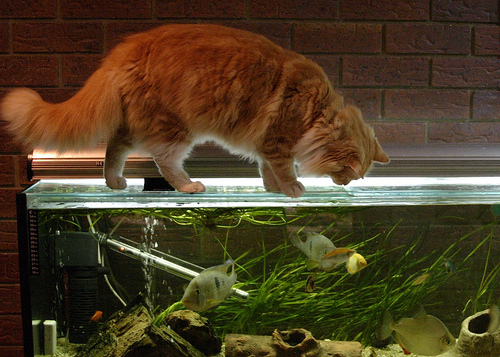
Lighting Systems and Hoods
Unless you wish to start your tank with live plants, you do not necessarily need a light or hood during the cycling process, but if you are going to use live plants, they will require a lighting system of some sort. For start up purposes for someone with no experience, I'd definitely recommend starting with simpler, easier to maintain plants with low light requirements. These types of plants will not require any special bulbs, and if you wish to you can always change your lighting later down the road to accommodate more demanding plants. With simpler plant life, you will also not need to worry about CO2 injection systems.
Even if you are not intending to grow any live plants, it may still be a good idea to go ahead and purchase your hood and lighting system at this point, if your tank did not come with it. Having a hood in place will slow down evaporation and protect your tank water from accumulating dust and pet hairs, as well as just keeping your cat at bay.
Other Start Up Supplies
You will need pure ammonia or an ammonia solution with water added (no other additives) to feed your tank and get the cycling process going, water dechlorinator, water testing supplies and a water siphon/gravel vacuum. The water testing supplies can be obtained via a couple of inexpensive 'dipsticks', but more sophisticated testing kits will give you more detailed and accurate readings. During the cycling process, an accurate ammonia reading is necessary. You can also bring a sample of your water in to most fish stores or pet stores, and they will test it for you, but you will need testing supplies on hand to determine ammonia and nitrite levels. Those are the two things you'll need to be concerned with during the cycling process.
Regarding the afore-mentioned water siphon/gravel vacuum, they come in a couple of sizes, be sure to get one that is appropriate for your tank size. The larger will never work in smaller tanks, and the smaller will be inadequate and annoying for a larger tank. For anything under 10 gallons, you will definitely want the smaller. For tanks over 10 gallons, the larger one will probably suit you best, but a smaller may be better depending on the height of the tank.
If you're going with the live plants, you'll want to add them as soon as possible to your tank. This will give them more time to grow, particularly if starting from rhizomes and bulbs.
A couple of five gallon buckets are really a good idea for transporting water to and from your tank -not just during start-up, but also for use during regular tank maintenance. One should be used exclusively for removing dirty water from the tank, the other for adding fresh, dechlorinated water to it. Just having one bucket for each purpose is fine, but for larger tanks it can be more convenient to have two buckets available for preparing fresh water to be added. You can get away with using the same bucket for removing water and for adding clean water afterwards, but be sure to rinse in between, and to wash and rinse well after each water change.
There are hose options available which attach to your sink, and if lifting is an issue for you, then you may want to look into these. Every gallon of water weighs over eight pounds.
Setting It All Up
It's best to have someone assist you with removing the new tank from the box, rinsing it to remove any dust and clinging package material, and placing it in position, especially if it is a larger tank. You should never pull on the frame or apply unnecessary pressure to any side of the tank, which may weaken the seals. Soap or other cleaning solutions aren't necessary on a new tank; just give it a good rinse.
It's also necessary to thoroughly rinse all gravel substrate. Use a large screen colander or your buckets and rinse in batches while stirring the substrate around with your hand to remove excess dye and dust. Once all of the rinsed gravel has been added to your tank, you can begin to add water.
At this point only, before your filtration system has been added, you do not have to worry about dechlorinating the water. Just keep pouring in buckets or pots full of tap water until you have reached a level of about four to six inches.
Stop to plant any plants -live or fake- which you may wish to add at this point. If planting in live plants, be sure to thoroughly rinse their root systems. Even if the plant is advertised as snail-free, that isn't always the case. Baby snails can be tiny little dots, so really spread the roots as much as possible and rinse thoroughly before adding the plants to your tank.
Plant live plants in the substrate the same way you would plant plants in a pot or in the ground. Spread the roots, and bury just up to the crown, unless instructed otherwise. Rhizomes should be left on top of the substrate as well. Bulbs can generally just be placed on top of the substrate as well, wherever you want them, but until they root, they will often be moved about by the water flow or curious fish. A pair of long handled tongs can be a handy tool to move them back to wherever you wish them. For more ideas on aquascaping and plant placement in your aquarium click here.
Rinse well any other tank decor you wish to add, and situate them amongst the substrate. To keep from disturbing plant placement and the gravel after you have arranged everything as you want it, use a plate or bowl to disburse water flow as you finish filling the tank with water. It's best to have one person hold the plate at an angle within the tank, while another person pours in the water. This will stop the force of the water from disturbing the gravel, plants and other decor.
Leave your water level a little below the filter output to create a greater surface disturbance. This will add more oxygen to the tank, which is helpful during the cycling process. Add water dechlorinator according to dosing instructions and then install the filter according to manufacturer instructions. Top it all off with your hood and lighting, and run your cords in a loop to an outlet that is protected from possible water spills. A surge protector is a good idea, which will also allow you to more easily turn the power on and off during tank maintenance.
Once everything is set up and running, you can add your first dose of ammonia to begin the cycling process. The cycling process can take up to six weeks to complete.
Depending on your choice of fish, the time of year and your normal household temperature, you may need to add an aquarium heater -if you have not already done so- before adding your fish. An installed heater can also help to speed up the cycling process.
An air pump is only necessary if your filtration system requires it, but they may also be used to add more motion to your tank, through air stones or decorative bubblers. Debate exists as to whether or not they actually add any oxygen to your water. It is also thought unnecessary air pumps may actually be detrimental to live plant growth, as the superfluous bubbling can remove needed CO2 from the tank.
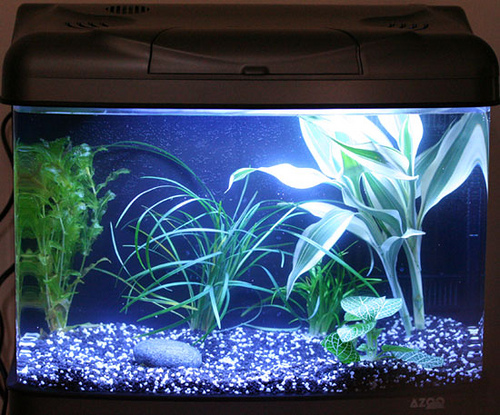
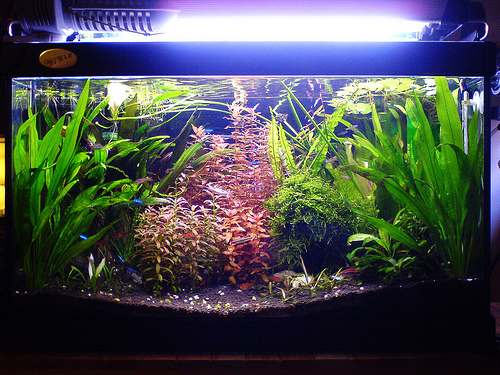
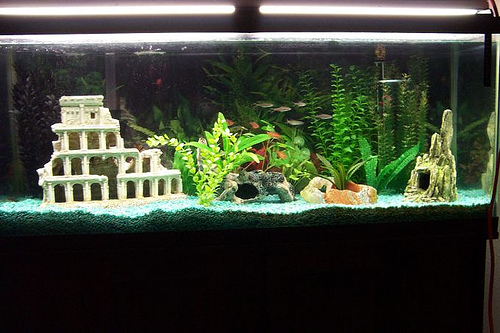
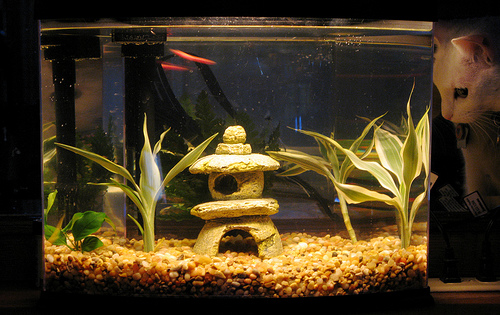
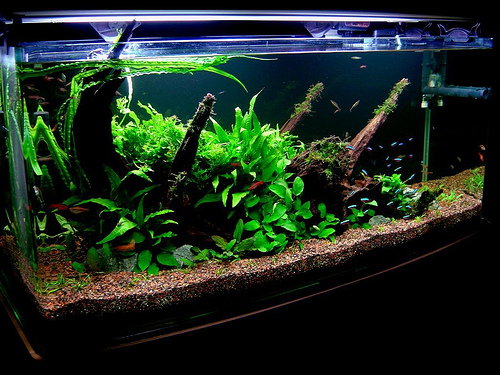
Add Fish and Enjoy!
Once your new tank has finished cycling and you have achieved optimal balanced water conditions, you can begin to slowly stock your tank with the fish you have decided on. It’s best to add only a few fish at a time. Start with the least territorial, to avoid having a territorial fish who thinks he can lay claim to the whole tank.
I hope this hub has been helpful to you, and that you enjoy your new fish keeping experience as much as I enjoy it. At first everything can sound complicated, but once you understand the basics, it all falls quickly into place. Sitting back and watching your fish swim about in a well designed fish tank can be a very soothing pastime.
However, the changes in your tank over time as plants grow and fish come to interact with each other in different ways make it an always interesting hobby. There are as well many more involved options in fish keeping, such as breedingand aquascaping, to keep a fish keeper happily busy for years to come.
Of course, if that isn't what you're looking for, fish keeping can also be a very simple endeavor, very well suited to the needs of someone seeking an undemanding pet, or just a water feature in their home or office. The trick to having a successful and satisfying fish tank is in finding what's right for you.
Thanks for reading! If you have any questions or other thoughts you'd like to share, please use the comment section below.
Happy fishkeeping!
